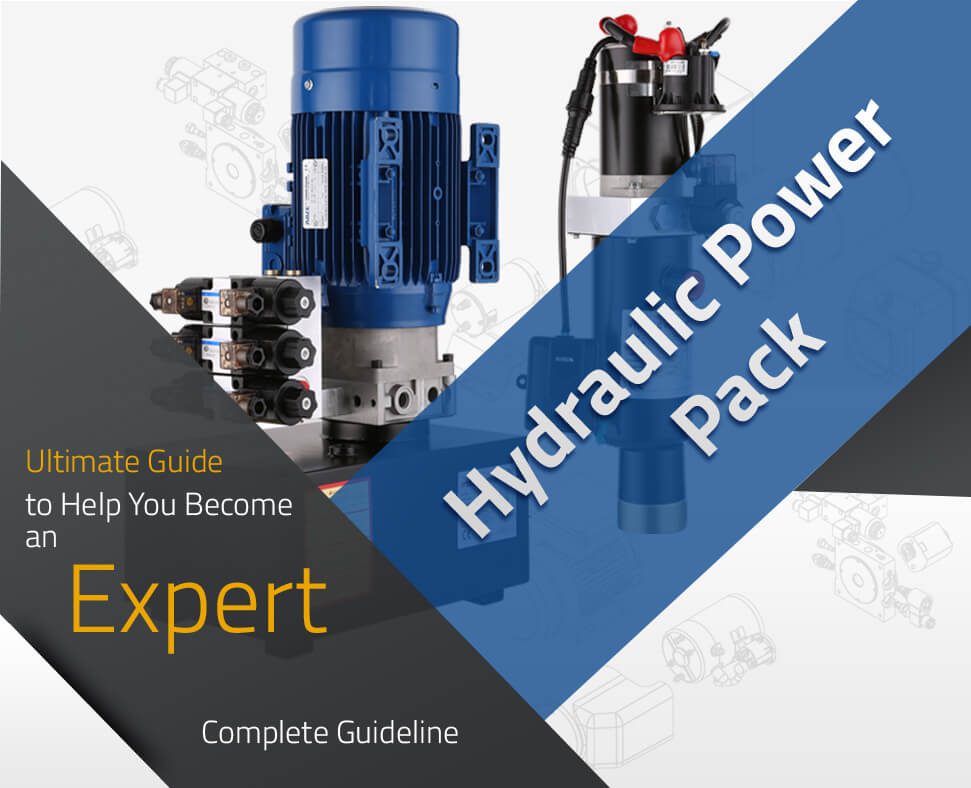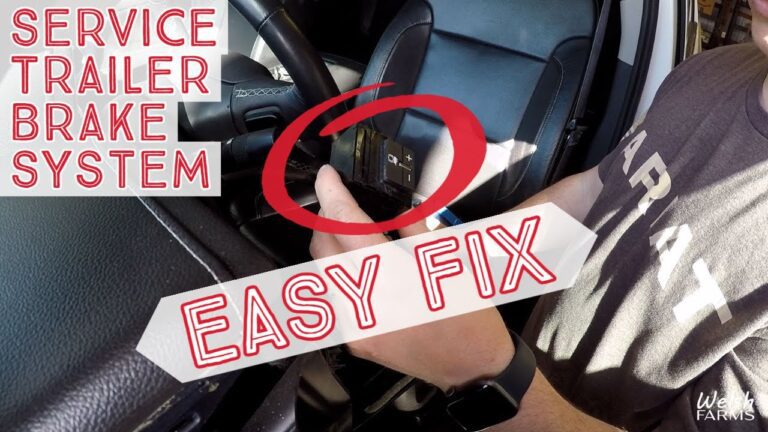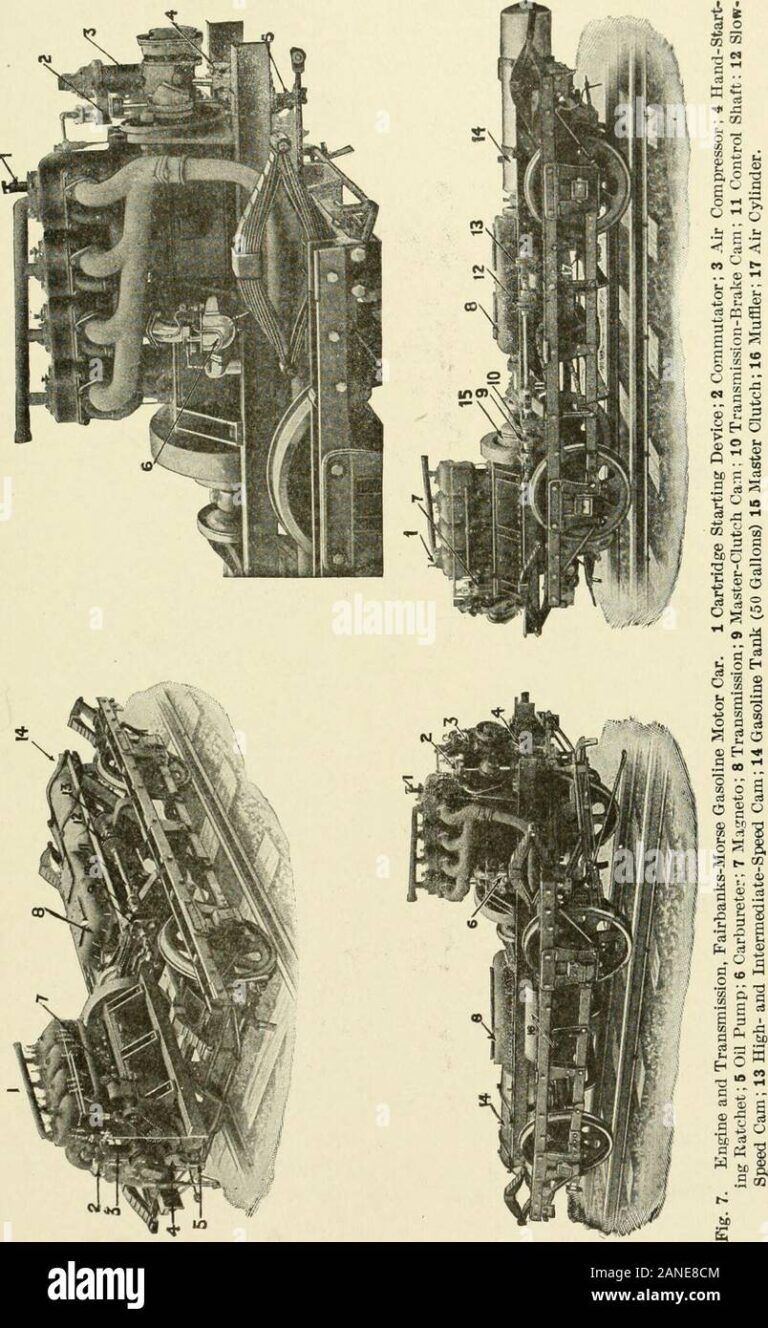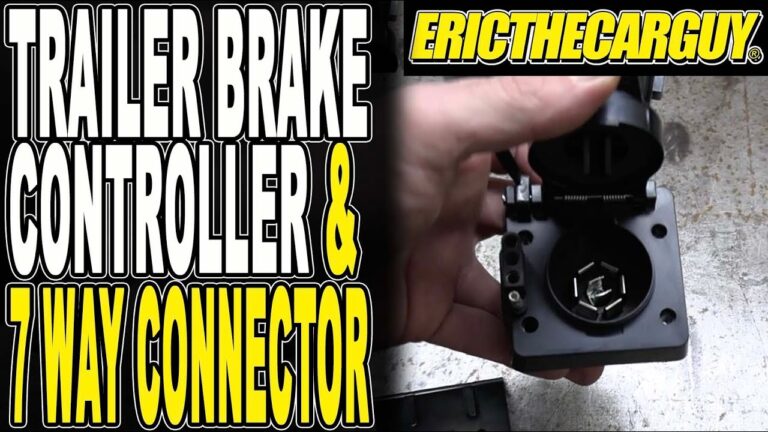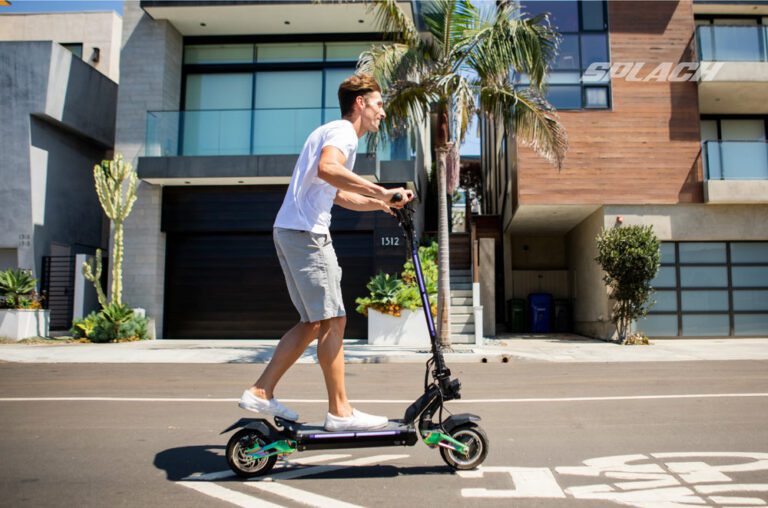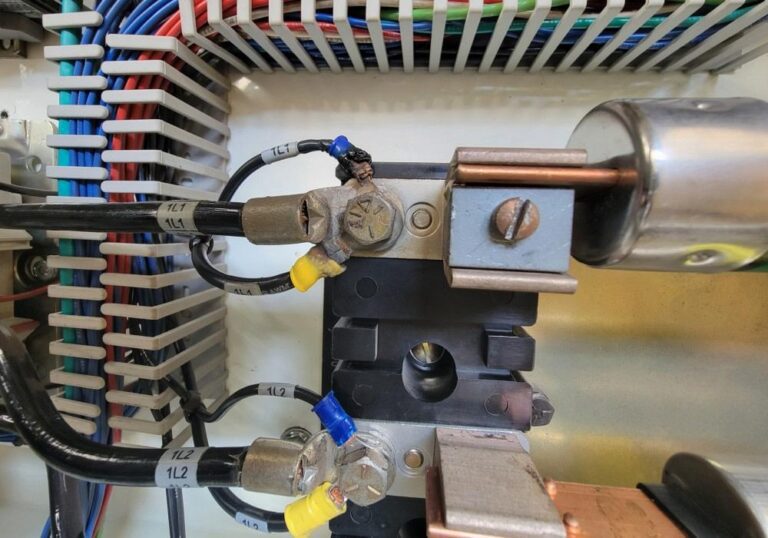Trailer Brake Controller Types: An Ultimate Guide for Power-Packed Performance
Trailer brake controllers are available in two types: time-delayed and proportional. Time-delayed controllers apply a preset amount of braking power, while proportional controllers adjust the braking power based on the vehicle’s deceleration.
These controllers are essential for safe towing, as they allow the trailer to brake simultaneously with the towing vehicle. Whether you are hauling a camper, boat, or other trailers, it is crucial to choose the right brake controller for your specific needs.
We will explore the differences between time-delayed and proportional controllers and provide valuable insights to help you make an informed decision.

Credit: www.amazon.com
How Trailer Brake Controllers Work
Understanding The Basic Principles Of Trailer Brake Control
Trailer brake controllers are an essential component for towing safely and efficiently. They ensure that your trailer’s brakes are synchronized with your vehicle, allowing for smoother stops and improved control. Understanding how these controllers work can help you choose the right one for your needs.
Here are the key points to keep in mind:
- Trailer brake controllers work by sending signals from your vehicle’s braking system to the trailer’s brakes, activating them when you apply the brakes in your vehicle.
- The controller measures the deceleration of your vehicle and adjusts the braking force applied to the trailer accordingly, ensuring a proportional response.
- There are three common types of trailer brake controllers: Time-delayed, proportional, and hydraulic.
- Time-delayed controllers provide a pre-set amount of braking force based on the time delay you select. These are commonly used for lighter trailers with consistent loads.
- Proportional controllers, on the other hand, apply braking force in direct proportion to the braking force in the towing vehicle. This results in smoother and more synchronized braking, making them suitable for a variety of trailer sizes and towing conditions.
- Hydraulic trailer brake controllers are designed for trailers equipped with hydraulic brakes. They use the hydraulic pressure applied by your vehicle’s brake pedal to activate the trailer’s brakes.
Now that we have covered the basics of how trailer brake controllers work, let’s explore the key components of a trailer brake controller system.
Components Of A Trailer Brake Controller System
A trailer brake controller system consists of several components that work together to provide smooth and reliable braking performance. Understanding these components will help you troubleshoot any issues and maintain your system properly. Here are the key components to be aware of:
- Brake controller unit: This is the main component of the system, typically mounted inside the vehicle. It receives signals from the vehicle’s braking system and sends commands to the trailer’s brakes.
- Brake pedal activation switch: This switch detects when the brake pedal is applied in the towing vehicle and sends a signal to the brake controller unit.
- Sensor: The sensor is responsible for measuring the deceleration and rate of change of speed in the towing vehicle. It provides crucial data to the brake controller unit for determining the appropriate amount of braking force to apply to the trailer.
- Bypass circuitry: Some trailer brake controllers are equipped with a bypass circuitry that allows you to manually override the braking force applied to the trailer. This feature can come in handy in emergency situations or when maneuvering in tight spaces.
- Connection wiring: Properly connecting the brake controller unit to the vehicle’s electrical system is crucial for optimal performance. It is important to follow the manufacturer’s instructions and use the recommended wiring harnesses and connectors.
By understanding the basic principles of trailer brake control and familiarizing yourself with the key components of a trailer brake controller system, you can make informed decisions when choosing and maintaining your trailer brake setup. Remember, safety should always be a top priority when towing, and having a well-functioning brake control system is vital for a smooth and controlled towing experience.
Benefits And Advantages Of Trailer Brake Controllers
Enhanced safety and control while towing:
- With a trailer brake controller, you can have better control over your trailer while towing, minimizing the risk of accidents or mishaps on the road. Here’s how it enhances safety:
- Allows you to independently control the braking force of your trailer, providing added stability and reducing the chances of swaying or fishtailing.
- Enables you to adjust the braking intensity based on the specific load and road conditions, ensuring optimal braking performance at all times.
- Gives you the ability to synchronize the braking action between your vehicle and trailer, helping maintain a smooth and controlled stop.
Increased braking efficiency and reduced wear on vehicle brakes:
- One of the significant advantages of trailer brake controllers is their ability to enhance braking efficiency and minimize wear on your vehicle’s brakes. Here are the key benefits:
- Distributes the braking force evenly between your vehicle and trailer, preventing excessive strain on the vehicle’s brakes, thereby prolonging their lifespan.
- Allows your vehicle’s brakes to cool down between braking cycles, reducing the risk of brake fade and ensuring consistent and reliable performance.
- Provides a proportional braking system, where the stopping force applied to the trailer is proportional to the deceleration of your vehicle, resulting in smoother and more controlled stops.
Trailer brake controllers offer enhanced safety and control while towing, allowing you to have better maneuverability and stability on the road. They also contribute to increased braking efficiency and reduce wear on your vehicle’s brakes, providing long-term benefits for both your vehicle and trailer.
By investing in a trailer brake controller, you can have peace of mind knowing that you’re taking necessary measures to ensure a safe and enjoyable towing experience.
Types Of Trailer Brake Controllers
Trailer brake controllers are essential devices that help ensure the safety and control of your trailer while towing. There are several different types of trailer brake controllers available, each with its own unique features and benefits. In this section, we will explore the four main types of trailer brake controllers: time-delayed, proportional, inertia-activated, hydraulic, and electric over hydraulic.
Let’s take a closer look at each type and understand how they function and the pros and cons associated with them.
Time-Delayed Brake Controllers
Time-delayed brake controllers, also known as solid-state brake controllers, are one of the most common types found in older model vehicles and trailers. These controllers apply a fixed amount of braking power based on a pre-set time delay, allowing the tow vehicle to stop before the trailer.
Here are the key points about time-delayed brake controllers:
- Function: Apply a preset amount of braking force after a certain duration of time delay.
- Advantages:
- Simplicity and affordability of installation.
- Can be manually adjusted to suit various trailer and load weights.
- Disadvantages:
- Lack of sensitivity to changes in towing conditions.
- Inconsistent braking power distribution in different situations.
Proportional Brake Controllers
Proportional brake controllers, also known as inertia-activated or proportional-integrated brake controllers, offer a more sophisticated and responsive braking experience. These controllers continuously measure the braking force of the tow vehicle and apply the trailer brakes accordingly. Here’s what you need to know about proportional brake controllers:
- Function: Apply braking force in proportion to the tow vehicle’s braking effort.
- Advantages:
- Smooth and proportional braking experience.
- Increased control and stability in various towing conditions.
- Enhanced safety by preventing trailer skidding or locking up.
- User-adjustable sensitivity settings to achieve optimal performance.
- Disadvantages:
- Higher cost compared to time-delayed brake controllers.
- May require professional installation for specific vehicle models.
Inertia-Activated Brake Controllers
Inertia-activated brake controllers, also known as pendulum or pendulum-based brake controllers, operate based on the trailer’s movement. These controllers use built-in pendulum sensors to detect the rate of deceleration and apply the appropriate amount of braking force. Let’s dive into the details of inertia-activated brake controllers:
- Function: Detect and respond to the trailer’s deceleration rate to activate trailer brakes.
- Advantages:
- Improved responsiveness to changes in towing conditions.
- Reduced likelihood of trailer skidding or loss of control.
- Disadvantages:
- Limited adjustability compared to proportional brake controllers.
- Potential for over-braking during sudden and extreme stops.
Hydraulic Brake Controllers
Hydraulic brake controllers are specifically designed for trailers equipped with hydraulic braking systems. These controllers use the hydraulic pressure generated by the tow vehicle’s braking system to activate the trailer brakes. Here’s what you should know about hydraulic brake controllers:
- Function: Utilize hydraulic pressure to engage the trailer brakes.
- Advantages:
- Seamless integration with trailers equipped with hydraulic brakes.
- Efficient and effective braking performance.
- Easy installation when the vehicle is equipped with a hydraulic brake system.
- Disadvantages:
- Incompatible with trailers equipped with electric braking systems.
- Limited versatility for vehicles without a hydraulic brake system.
Electric Over Hydraulic Brake Controllers
Electric over hydraulic brake controllers combine the best features of electric and hydraulic brake controllers. These controllers convert the electric brake signal from the tow vehicle into hydraulic pressure to activate the trailer brakes. Let’s explore the advantages and considerations of electric over hydraulic brake controllers:
- Function: Convert electric brake signal into hydraulic pressure for trailer brake activation.
- Benefits:
- Optimal braking control and performance for trailers with hydraulic brakes.
- Ability to tow trailers with both electric and hydraulic braking systems.
- Seamless integration with the vehicle’s existing electric brake controller.
- Considerations:
- Higher cost compared to other types of brake controllers.
- More complex installation process, often requiring professional assistance.
By understanding the different types of trailer brake controllers, you can choose the one that best suits your towing needs and ensure a safer and more controlled towing experience. Whether you opt for a time-delayed, proportional, inertia-activated, hydraulic, or electric over hydraulic brake controller, make sure to consider the specific features and limitations of each type to make an informed decision.
Factors To Consider When Choosing A Trailer Brake Controller
When it comes to choosing a trailer brake controller, there are several important factors to consider. The right controller will ensure the safe and effective operation of your trailer’s brakes, providing you with peace of mind during your towing adventures.
Here are the key factors you should keep in mind:
Weight Rating And Compatibility With Towing Setup
- The weight rating of a brake controller is crucial, as it determines the maximum weight it can handle. Ensure that the controller you choose is suitable for your trailer’s weight and towing setup.
- Consider the type of trailer you are towing. Different trailers may require specific brake controller types, so it’s important to choose one that is compatible with your setup.
- If you frequently tow trailers of varying sizes or weights, opt for a brake controller with adjustable weight settings. This flexibility will allow you to easily adapt to different towing situations.
Installation Options And Ease Of Use
- Before purchasing a trailer brake controller, consider the installation options available. Some controllers require professional installation, while others offer straightforward do-it-yourself setups. Choose the option that best suits your skill level and convenience.
- Ease of use is vital when it comes to brake controllers. Look for controllers with user-friendly interfaces and intuitive controls. This will ensure that you can easily adjust braking settings and operate the controller without any hassle.
- Keep in mind the location where you plan to install the brake controller. Choose a controller with a compact design if you have limited space available. Additionally, consider controllers with wireless or remote capabilities for added convenience.
Pricing And Additional Features
- Price is an important consideration when choosing a trailer brake controller. Set a budget and look for controllers within your price range. Remember that higher-priced controllers often offer more advanced features.
- Apart from basic braking functionality, many brake controllers offer additional features that enhance safety and convenience. These features can include monitoring systems, diagnostic tools, or compatibility with trailer sway control systems. Consider which additional features are important for your specific towing needs.
Choosing the right trailer brake controller involves considering factors such as weight rating, compatibility, installation options, ease of use, pricing, and additional features. By evaluating these factors, you can select a brake controller that ensures optimal braking performance and enhances your towing experience.
Installation And Setup Of Trailer Brake Controllers
Step-By-Step Guide To Installing A Trailer Brake Controller
Installing a trailer brake controller is a crucial step in ensuring the safe and efficient operation of your trailer. Follow these steps to install a trailer brake controller on your vehicle:
- Identify the correct location: Choose a suitable location to mount the brake controller within easy reach of the driver’s seat, usually under the dashboard. Ensure it is secure and easily accessible for adjustments.
- Disconnect the battery: Before beginning any electrical work, disconnect the negative terminal of the vehicle’s battery to avoid any potential electrical hazards.
- Locate the wiring harness: Find the vehicle’s brake control wiring harness either under the dashboard or near the driver’s side kick panel. It is generally a bundle of wires with a connector.
- Connect the wiring harness: Plug the wiring harness from the brake controller into the vehicle’s brake control wiring harness. Make sure the connectors fit securely and are properly aligned.
- Mount the brake controller: Use screws or brackets to securely mount the brake controller in the chosen location. Ensure it is firmly attached to prevent any movement while driving.
- Connect the power supply: Identify the vehicle’s power supply wire, usually located at the vehicle’s fuse box under the hood. Connect the brake controller’s power wire to this wire using a wire tap connector or soldering.
- Connect the ground wire: Find a suitable grounding point near the brake controller location, such as a metal surface or screw. Connect the brake controller’s ground wire securely to this point.
- Test the connections: Ensure all connections are secure and tightened. Reconnect the negative battery terminal and test the brake controller to verify that it powers on and responds correctly.
- Adjust the brake controller settings: Sit in the driver’s seat and adjust the brake controller’s gain or sensitivity settings based on the trailer’s weight and braking requirements. Consult the brake controller’s manual for precise instructions.
- Test the trailer brakes: With the trailer connected and the brake controller properly adjusted, test the trailer brakes in a safe area, such as an empty parking lot. Gradually apply the brakes and observe the trailer’s response.
Setting Up And Calibrating The Controller For Optimal Performance
To ensure the trailer brake controller operates at its best, follow these steps to set up and calibrate it:
- Consult the manual: Read the brake controller’s manual thoroughly to understand its features, settings, and calibration procedures. Each brake controller may have specific instructions.
- Adjust the gain setting: Begin by adjusting the gain setting to establish how much trailer braking force is applied. Start with a low gain setting and gradually increase it while driving and braking until the trailer brakes effectively without skidding.
- Monitor the brake response: Pay attention to how the trailer responds to different braking settings. Adjust the gain setting higher or lower as needed to achieve the desired braking performance.
- Fine-tune other settings if available: Some brake controllers may offer additional settings, such as response time or manual override. Experiment with these settings to ensure optimal performance in different driving conditions.
- Regularly check and re-calibrate: It’s important to periodically review and re-calibrate the brake controller as needed. Changes in trailer weight, driving conditions, or towing preferences may require adjustments to maintain optimal performance.
Remember, proper installation and calibration of your trailer brake controller are essential for safe towing. If you are unsure about any step or encounter difficulties, consult a professional or refer to the brake controller’s manufacturer for assistance.
Maintenance And Troubleshooting Tips For Trailer Brake Controllers
Trailer Brake Controller Types
Regular inspection and cleaning procedures:
- Regularly inspect the trailer brake controller to ensure it is in good working condition.
- Check for any signs of wear or damage, such as frayed wires or loose connections.
- Keep the controller clean and free from dirt, dust, and debris.
- Use a soft cloth or brush to gently clean the surface of the controller.
- Avoid using harsh chemicals or abrasive cleaners, as these can damage the controller.
- Pay special attention to the buttons and knobs, making sure they are clean and functioning properly.
- Inspect the wiring connections to ensure they are secure and free from corrosion.
- Test the controller regularly to ensure it is properly functioning before each use.
Common issues and solutions for trailer brake controllers:
- No power to the controller:
- Check the fuse and replace if necessary.
- Ensure the wiring connections are secure and free from corrosion.
- Make sure the battery is fully charged.
- Inconsistent braking action:
- Check the brake pads and replace if worn out.
- Adjust the brake gain setting on the controller to the appropriate level for the trailer’s weight.
- Ensure the trailer brakes are properly adjusted and not dragging.
- Brake activation delay:
- Check the wiring connections for any loose or corroded wires.
- Adjust the brake gain setting to increase or decrease the responsiveness of the trailer brakes.
- Inspect the brake magnets and replace if necessary.
- Overactive brakes:
- Reduce the brake gain setting to decrease the braking intensity.
- Inspect the brake magnets and clean or replace if needed.
- Error codes or flashing lights on the controller:
- Consult the owner’s manual to determine the meaning of the error code.
- Follow the troubleshooting steps provided in the manual to resolve the issue.
- If the problem persists, seek professional assistance.
Remember to always consult the owner’s manual for specific instructions on maintenance and troubleshooting for your trailer brake controller. Regular inspection and maintenance will help ensure the safe and efficient operation of your trailer brakes.
Frequently Asked Questions (Faqs)
Can I Install A Trailer Brake Controller Myself?
Installing a trailer brake controller may seem like a daunting task, but with the right knowledge and tools, it is something that you can do yourself. Here are some key points to keep in mind:
- Understand your vehicle: Before attempting to install a trailer brake controller, make sure you understand the electrical and braking systems of your vehicle. Familiarize yourself with the owner’s manual and any specific instructions provided by the manufacturer.
- Choose the right controller: There are different types of trailer brake controllers available, including time-delayed and proportional controllers. Research and choose the one that best suits your needs and towing requirements.
- Gather the necessary tools: Before starting the installation process, gather all the tools you will need. This may include wire cutters, crimpers, electrical tape, and a wiring harness.
- Follow the instructions: Every trailer brake controller comes with a set of instructions. Follow them carefully to ensure a successful installation. If you’re unsure about any step, consult a professional or contact the manufacturer for assistance.
- Safety first: Make sure to disconnect the vehicle’s battery before working on any electrical components. This will prevent any potential accidents or damage.
What Happens If My Trailer Brake Controller Fails?
A trailer brake controller is a crucial component of your towing setup, as it allows you to control the braking force of your trailer. However, like any electronic device, it can sometimes fail. Here are a few things to keep in mind in such situations:
- Loss of trailer braking control: If your trailer brake controller fails, you may experience a loss of control over the braking force of your trailer. This can result in longer stopping distances, increased wear on your vehicle’s brakes, and potentially dangerous situations on the road.
- Check the wiring and connections: Before assuming that your trailer brake controller has failed, check the wiring and connections. Loose or damaged wires can cause issues with the functioning of the controller. Ensure that all connections are secure and free from damage or corrosion.
- Consider professional assistance: If you’re unable to diagnose or fix the issue yourself, it may be necessary to seek professional assistance. A qualified technician will have the expertise and tools to troubleshoot and repair any problems with your trailer brake controller.
- Regular maintenance: To minimize the risk of failure, it’s important to regularly inspect and maintain your trailer brake controller. Clean any debris that may accumulate around the controller, check for any signs of wear or damage, and test its functionality before every towing trip.
Is It Necessary To Have A Trailer Brake Controller?
If you’re towing a trailer that exceeds a certain weight, a trailer brake controller is not just necessary, it’s mandatory in many regions. Here are a few key points to consider:
- Legal requirements: Depending on your location, the law may require you to have a trailer brake controller if your trailer exceeds a certain weight, such as 1,500 or 2,000 pounds. Ignoring these requirements can lead to fines and penalties.
- Safety considerations: Towing a heavy trailer without a brake controller can put a strain on your vehicle’s braking system, resulting in longer stopping distances and increased wear on your brakes. A trailer brake controller allows you to evenly distribute the braking force between your vehicle and the trailer, improving safety on the road.
- Smooth and controlled braking: With a trailer brake controller, you have the ability to adjust the braking force of your trailer to match the weight and conditions. This ensures smooth and controlled braking, reducing the risk of accidents and providing a more comfortable towing experience.
- Peace of mind: Having a trailer brake controller installed gives you peace of mind, knowing that you have the necessary control over your trailer’s braking system. It allows you to confidently tow heavy loads, knowing that you can stop safely when needed.
Remember, always refer to your local laws and regulations to determine the specific requirements for trailer brake controllers in your area.
Frequently Asked Questions On Trailer Brake Controller Types
What Are The Different Types Of Trailer Brake Controllers?
Trailer brake controllers are categorized into three types: time-delayed, proportional, and hydraulic. Each type has its own advantages and uses.
How Does A Time-Delayed Brake Controller Work?
A time-delayed brake controller applies a preset amount of braking power on a time delay basis. It is ideal for trailers with similar loads and road conditions.
What Is A Proportional Brake Controller?
A proportional brake controller senses the intensity of brake pressure applied by the tow vehicle and applies the corresponding amount of braking power to the trailer.
How Does A Hydraulic Brake Controller Function?
A hydraulic brake controller is specifically designed for trailers with hydraulic brakes. It uses the hydraulic pressure from the tow vehicle’s braking system to activate the trailer brakes.
Which Brake Controller Type Is Best For Towing Heavy Loads?
For towing heavy loads, a proportional brake controller is recommended as it provides precise braking power based on the tow vehicle’s braking system.
What Are The Benefits Of Using A Trailer Brake Controller?
A trailer brake controller enhances safety by ensuring efficient braking, reduces wear and tear on the tow vehicle, and improves overall towing performance.
Do I Need A Brake Controller For My Trailer?
If your trailer has electric brakes, then yes, you need a brake controller installed in your tow vehicle to control the trailer’s braking system.
Can I Install A Brake Controller Myself?
If you have basic electrical knowledge and experience, you can install a brake controller yourself by following the manufacturer’s installation instructions and guidelines.
Are All Brake Controllers Compatible With Any Tow Vehicle?
Not all brake controllers are compatible with all tow vehicles. It is crucial to check the compatibility of the brake controller with your specific tow vehicle before making a purchase.
How Do I Choose The Right Brake Controller For My Trailer?
Consider factors such as the trailer’s weight, braking system type, towing conditions, and your personal preferences when selecting a brake controller that suits your needs.
Conclusion
Understanding the different types of trailer brake controllers is crucial for safe and efficient towing. Whether you opt for a time-delayed brake controller or a proportional one, each type has its advantages and considerations. Time-delayed controllers are cost-effective and easy to install, making them a popular choice for occasional or light towing.
However, they lack the precision of proportional controllers, which offer smoother and more precise braking. Proportional controllers are particularly useful when towing in various terrains and load conditions, as they automatically adjust the braking force to match the speed and intensity of the vehicle.
This ensures a safer and smoother towing experience. Ultimately, your choice of trailer brake controller will depend on your specific towing needs and budget. It is important to do your research, consult with experts, and ensure that you select a reliable and compatible controller for your trailer.
With the right brake controller in place, you can travel with peace of mind, knowing that your trailer’s braking system is functioning optimally and contributing to the safety of your journey.

